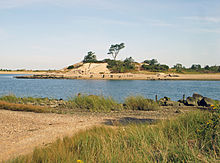Belle Terre, New York
Belle Terre is a village in the Town of Brookhaven in Suffolk County, on the North Shore of Long Island, in New York, United States.
In 1902, the Port Jefferson Company purchased the Oakwood estate with the purpose of creating an exclusive waterfront development of fifty houses to rival the communities of Long Island's traditional Gold Coast.
The well-connected real-estate developer, Dean Alvord, was chosen as president of Belle Terre's estates, which was incorporated in 1906.
[3] The Belle Terre Club was destroyed in a fire in 1934, the same year as the pergolas were deconstructed due to the financial burden of their upkeep.
Due to a lapse in insurance coverage, the clubhouse was never rebuilt although a new country club opened in the Port Jefferson section of the Mt.
During the 1920s and 1930s, the community's residents staged a successful campaign against sand and gravel companies who began dredging operations in the area.
For several decades prior to her death in 2014, Belle Terre was the principal home of Nadia de Navarro Farber, a Bulgarian-born countess (by her second of four marriages) who donated considerably to the John T. Mather Memorial Hospital in neighboring Port Jefferson Village.
Farber alternated her residence between a landmark pink mansion near the tip of Belle Terre and her castle on the Caribbean island of Saint Croix.
In 1974, in the case Village of Belle Terre v. Boraas,[8] the Supreme Court of the United States, an opinion written by Justice William O. Douglas held that it was constitutional to forbid more than two people unrelated by blood, adoption, or marriage — not counting household servants — from living and cooking together as a single housekeeping unit in the village for the purpose of maintaining a quiet residential sector.


